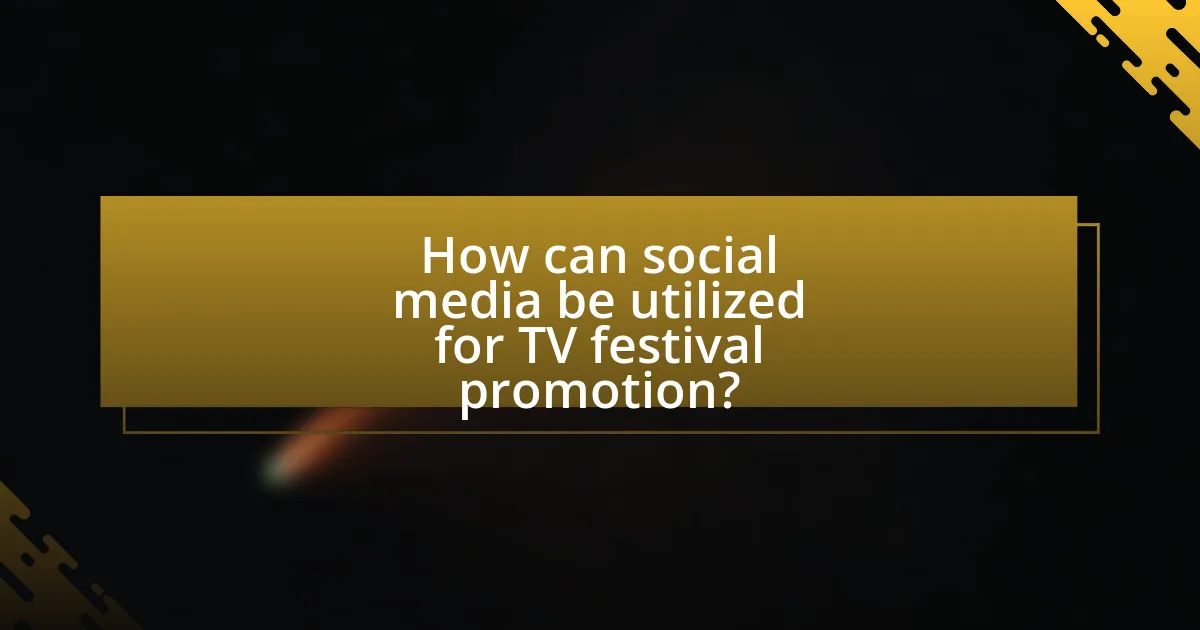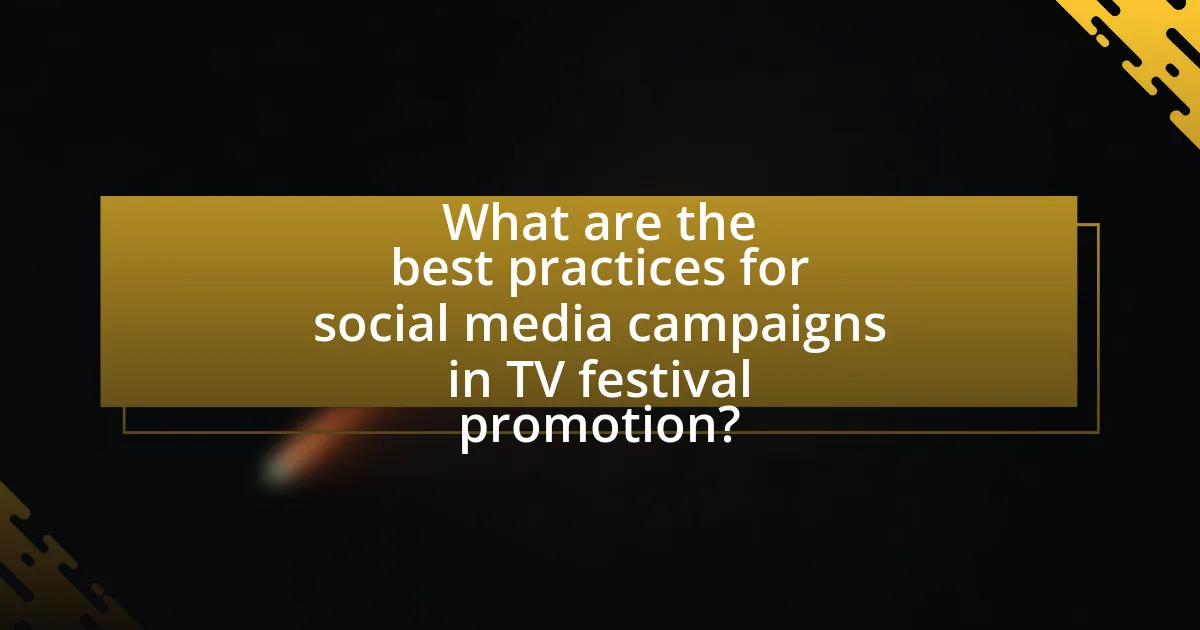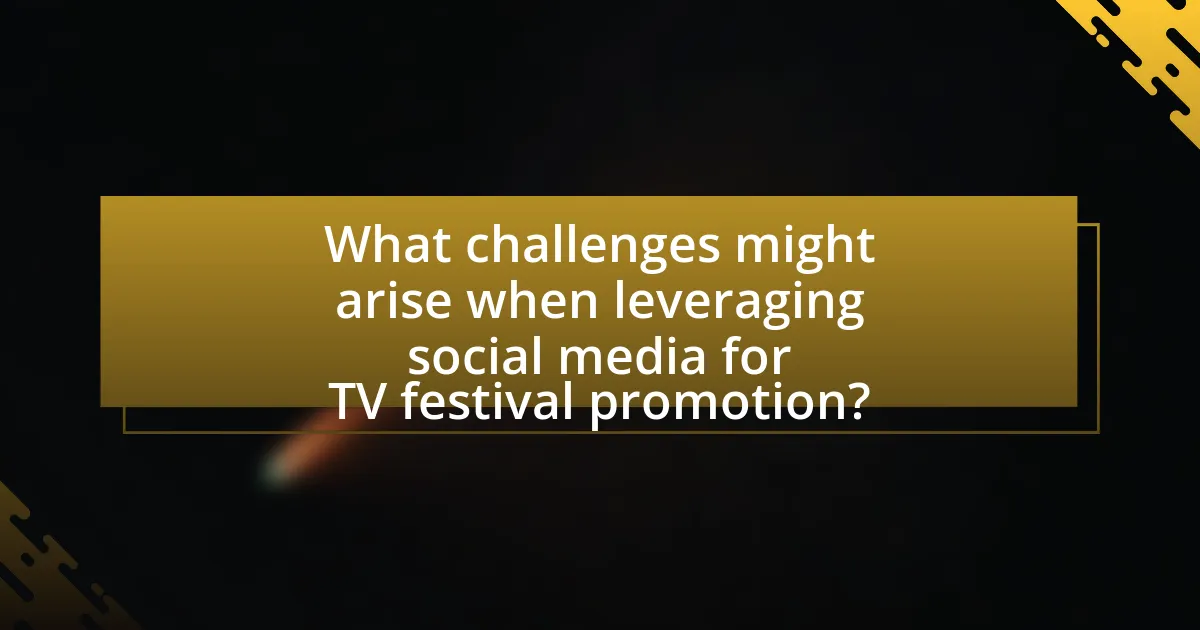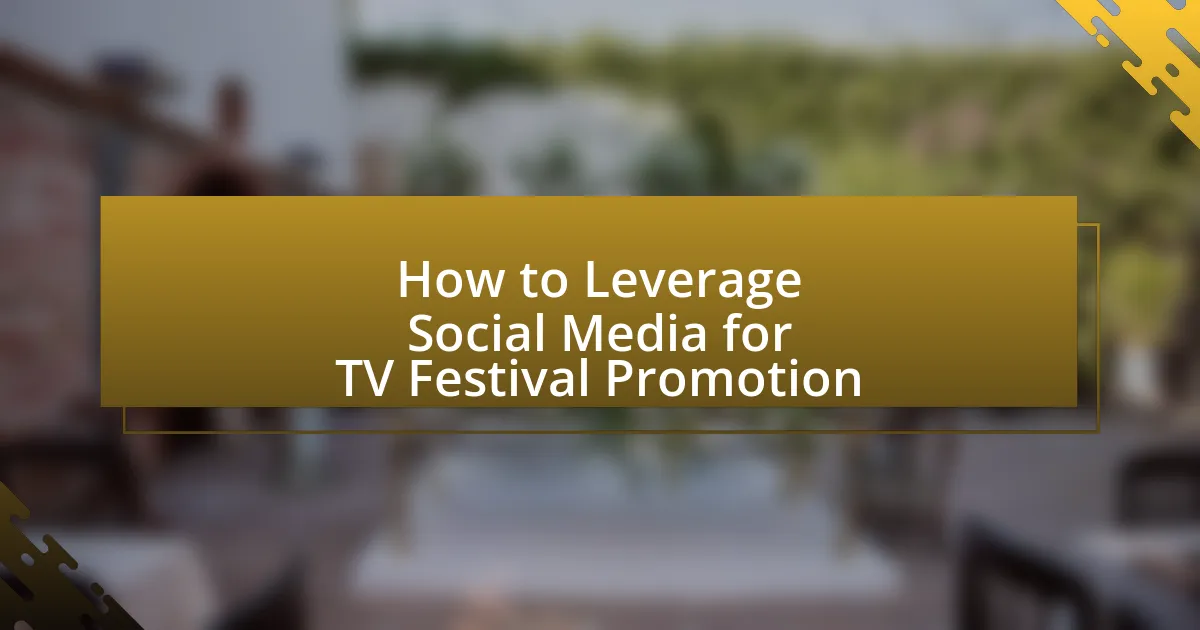The article focuses on leveraging social media for TV festival promotion, emphasizing the importance of engaging content and audience interaction across key platforms such as Facebook, Instagram, Twitter, and TikTok. It outlines strategies for maximizing impact, including targeted advertising, content creation tailored to specific demographics, and the use of user-generated content. Additionally, the article discusses the role of partnerships and collaborations, best practices for social media campaigns, and methods for measuring success through engagement metrics. Challenges such as managing negative feedback and maintaining consistent messaging are also addressed, providing a comprehensive guide for effectively promoting TV festivals through social media.

How can social media be utilized for TV festival promotion?
Social media can be utilized for TV festival promotion by creating engaging content that highlights festival events, showcases behind-the-scenes footage, and encourages audience interaction. Platforms like Instagram, Twitter, and Facebook allow for real-time updates and audience engagement, which can increase visibility and excitement around the festival. For instance, a study by the Pew Research Center indicates that 69% of adults in the U.S. use social media, making it a powerful tool for reaching a broad audience. Additionally, targeted advertising on these platforms can effectively reach specific demographics interested in television and entertainment, further enhancing promotional efforts.
What are the key social media platforms for promoting TV festivals?
The key social media platforms for promoting TV festivals are Facebook, Instagram, Twitter, and TikTok. Facebook allows for targeted advertising and event creation, making it effective for reaching diverse audiences. Instagram’s visual focus is ideal for sharing engaging content, such as trailers and behind-the-scenes footage, which can attract viewers. Twitter facilitates real-time engagement and updates, enabling conversations around the festival and its programming. TikTok’s short-form video format is particularly effective for reaching younger demographics through creative and viral content. These platforms collectively enhance visibility and engagement for TV festivals, leveraging their unique features to connect with audiences.
How does each platform cater to different audience demographics?
Different social media platforms cater to various audience demographics through their unique features and user bases. For instance, Facebook primarily attracts a diverse age range, with a significant number of users aged 25-34, making it suitable for targeting adults and families. Instagram, on the other hand, skews younger, with a majority of users aged 18-24, which allows brands to engage with a more youthful audience through visually appealing content. Twitter serves a broad demographic but is particularly popular among professionals and news enthusiasts, making it effective for real-time updates and engagement. TikTok, with its predominantly Gen Z user base, focuses on short, entertaining videos, appealing to younger audiences seeking creative and viral content. Each platform’s user demographics influence how content is created and shared, allowing marketers to tailor their strategies effectively for specific audience segments.
What unique features do these platforms offer for event promotion?
Social media platforms offer unique features for event promotion, including targeted advertising, event-specific hashtags, and real-time engagement tools. Targeted advertising allows promoters to reach specific demographics based on interests, location, and behavior, enhancing the likelihood of attracting the right audience. Event-specific hashtags facilitate community building and increase visibility, enabling users to easily find and engage with event-related content. Real-time engagement tools, such as live streaming and interactive polls, foster immediate interaction between organizers and attendees, creating a dynamic promotional environment. These features collectively enhance the effectiveness of event promotion on social media platforms.
Why is social media important for TV festival promotion?
Social media is crucial for TV festival promotion because it enables direct engagement with audiences and amplifies reach. By utilizing platforms like Twitter, Instagram, and Facebook, festivals can share real-time updates, behind-the-scenes content, and interactive posts that foster community involvement. According to a 2021 study by the Pew Research Center, 69% of adults in the U.S. use social media, making it an effective channel for reaching a broad demographic. Additionally, social media allows for targeted advertising, which can increase ticket sales and attendance by reaching specific audience segments interested in television and entertainment.
How does social media enhance audience engagement?
Social media enhances audience engagement by facilitating real-time interaction and fostering community among users. Platforms like Facebook, Twitter, and Instagram allow audiences to share their thoughts, experiences, and feedback instantly, creating a dialogue between content creators and viewers. According to a study by the Pew Research Center, 69% of adults in the U.S. use social media, which indicates a significant opportunity for brands to connect with their audience. Additionally, social media algorithms prioritize engaging content, meaning posts that generate likes, shares, and comments are more likely to reach a broader audience, further amplifying engagement.
What role does social media play in building community around TV festivals?
Social media plays a crucial role in building community around TV festivals by facilitating real-time engagement and interaction among fans, creators, and industry professionals. Platforms like Twitter, Instagram, and Facebook enable users to share experiences, discuss content, and connect with others who share similar interests, thereby fostering a sense of belonging. For instance, during events like the Sundance Film Festival, social media hashtags are widely used to create a collective conversation, allowing attendees and viewers to participate in discussions and share insights, which enhances community involvement. Additionally, studies show that 70% of festival-goers use social media to connect with others attending the same event, highlighting its effectiveness in community building.
What strategies can be employed to maximize social media impact?
To maximize social media impact for TV festival promotion, employing targeted content strategies is essential. Creating engaging, visually appealing content tailored to the audience’s preferences can significantly enhance interaction rates. For instance, using high-quality images and videos related to festival highlights can attract more viewers. Additionally, leveraging analytics tools to track engagement metrics allows for data-driven adjustments to content strategies, ensuring that posts resonate with the audience. Research indicates that posts with visuals receive 94% more views than text-only posts, underscoring the importance of multimedia in social media engagement. Furthermore, utilizing hashtags strategically can increase visibility, as posts with at least one hashtag can see a 12.6% increase in engagement compared to those without.
How can content creation be tailored for social media audiences?
Content creation can be tailored for social media audiences by focusing on platform-specific formats, engaging visuals, and concise messaging. Each social media platform has unique characteristics; for instance, Instagram prioritizes visual content, while Twitter favors brevity. Research indicates that posts with images receive 94% more views than text-only posts, highlighting the importance of engaging visuals. Additionally, using interactive elements like polls or stories can enhance audience engagement, as studies show that interactive content generates 2 times more conversions than static content. By understanding audience preferences and behaviors on different platforms, content can be optimized to increase reach and engagement effectively.
What types of posts generate the most engagement for TV festivals?
Video content and behind-the-scenes posts generate the most engagement for TV festivals. Research indicates that video posts receive 48% more engagement than image posts on social media platforms. Additionally, behind-the-scenes content offers exclusive insights, making audiences feel more connected and invested, which can lead to a 30% increase in shares and comments. This combination of engaging video and exclusive content effectively captures audience interest and drives interaction.
How can partnerships and collaborations enhance social media efforts?
Partnerships and collaborations can significantly enhance social media efforts by expanding reach and increasing engagement. When organizations or individuals team up, they can tap into each other’s audiences, thereby amplifying their message and attracting new followers. For instance, a study by Nielsen found that 92% of consumers trust recommendations from individuals over brands, highlighting the effectiveness of collaborative promotions. Additionally, partnerships can lead to co-created content that resonates more with diverse audiences, fostering a sense of community and shared interest. This collaborative approach not only boosts visibility but also enhances credibility, as audiences perceive partnered entities as more trustworthy.
What types of partnerships are most effective for TV festival promotion?
Strategic partnerships with social media influencers, local businesses, and media outlets are most effective for TV festival promotion. Influencers can amplify reach and engagement by sharing festival content with their followers, while local businesses can provide cross-promotional opportunities that attract community interest. Collaborating with media outlets ensures coverage and visibility, leveraging their established audiences to enhance festival awareness. For instance, a study by the Interactive Advertising Bureau found that influencer marketing can yield an ROI of up to 11 times the investment, demonstrating the effectiveness of these partnerships in driving attendance and engagement for events like TV festivals.
How can influencers be leveraged to boost visibility?
Influencers can be leveraged to boost visibility by collaborating with them to create authentic content that resonates with their audience. This strategy allows brands to tap into the influencer’s established trust and reach, significantly increasing exposure. For instance, a study by the Digital Marketing Institute found that 49% of consumers depend on influencer recommendations when making purchasing decisions, highlighting the effectiveness of influencer partnerships in enhancing visibility.

What are the best practices for social media campaigns in TV festival promotion?
The best practices for social media campaigns in TV festival promotion include creating engaging content, utilizing targeted advertising, and fostering community interaction. Engaging content, such as behind-the-scenes footage and interviews with cast members, captures audience interest and encourages sharing. Targeted advertising allows for reaching specific demographics, maximizing the campaign’s effectiveness; for instance, Facebook’s ad platform enables advertisers to target users based on interests related to television and film. Fostering community interaction through live Q&A sessions or polls enhances audience engagement and builds a loyal fan base. These practices are supported by studies showing that campaigns with high engagement rates lead to increased attendance and viewership, demonstrating their effectiveness in promoting TV festivals.
How can a content calendar improve social media strategy?
A content calendar can significantly improve social media strategy by providing a structured plan for content creation and distribution. This structured approach ensures consistent posting, which is crucial for audience engagement and brand visibility. Research indicates that brands that post consistently see a 67% increase in engagement compared to those that do not. Additionally, a content calendar allows for better alignment of content with marketing goals and events, ensuring that promotional activities, such as TV festival announcements, are timely and relevant. By planning ahead, teams can also allocate resources more effectively, reducing last-minute stress and enhancing overall content quality.
What key elements should be included in a content calendar?
A content calendar should include key elements such as publication dates, content types, target audience, platforms for distribution, and specific themes or campaigns. These elements ensure organized planning and execution of content strategies. For instance, having clear publication dates helps maintain a consistent posting schedule, while identifying content types (e.g., videos, blog posts, social media updates) allows for diverse engagement. Target audience specifications ensure that content resonates with the intended viewers, and selecting platforms for distribution maximizes reach. Lastly, incorporating themes or campaigns aligns content with promotional goals, particularly relevant in contexts like TV festival promotions where timing and audience engagement are critical.
How often should content be posted leading up to the festival?
Content should be posted at least three to five times per week leading up to the festival. This frequency helps maintain audience engagement and builds anticipation. Research indicates that consistent posting increases visibility and interaction rates, with studies showing that brands posting multiple times a week can see up to 50% higher engagement compared to those posting less frequently. Therefore, a strategic approach of three to five posts weekly is effective for maximizing reach and engagement in the context of festival promotion.
What metrics should be tracked to measure success?
To measure success in leveraging social media for TV festival promotion, key metrics include engagement rate, reach, impressions, follower growth, and conversion rate. Engagement rate quantifies interactions (likes, shares, comments) relative to total followers, indicating audience interest. Reach measures the total number of unique users who see the content, while impressions count total views, reflecting visibility. Follower growth tracks the increase in audience size, essential for assessing brand awareness. Conversion rate evaluates the percentage of users taking desired actions, such as ticket purchases or sign-ups, demonstrating the effectiveness of promotional efforts. These metrics provide a comprehensive view of social media performance and its impact on festival promotion.
How can engagement rates inform future strategies?
Engagement rates can inform future strategies by providing insights into audience preferences and content effectiveness. Analyzing engagement metrics, such as likes, shares, and comments, allows marketers to identify which types of content resonate most with their audience. For instance, a study by Sprout Social found that posts with higher engagement rates typically lead to increased brand loyalty and customer retention. By leveraging this data, organizations can tailor their social media campaigns to focus on content that drives interaction, ultimately enhancing their promotional efforts for events like TV festivals.
What tools can be used to analyze social media performance?
Tools that can be used to analyze social media performance include Hootsuite, Sprout Social, and Google Analytics. Hootsuite provides comprehensive analytics on engagement, reach, and audience demographics across multiple platforms. Sprout Social offers detailed reporting features that track performance metrics and audience interactions, enabling users to optimize their social media strategies. Google Analytics allows for tracking referral traffic from social media channels, providing insights into user behavior and conversion rates. These tools are widely recognized for their effectiveness in measuring and enhancing social media performance.
How can user-generated content be encouraged and utilized?
User-generated content can be encouraged and utilized by creating interactive campaigns that incentivize audience participation. For instance, social media platforms can host contests or challenges where users submit their own content related to the TV festival, such as fan art or video testimonials. This approach not only fosters community engagement but also generates authentic content that can be shared across promotional channels. According to a study by Nielsen, 92% of consumers trust user-generated content more than traditional advertising, highlighting its effectiveness in building credibility and attracting attention. By showcasing this content on official festival pages, organizers can enhance visibility and create a sense of ownership among participants, further driving engagement and interest in the event.
What strategies can be implemented to motivate attendees to share their experiences?
To motivate attendees to share their experiences, organizers can implement strategies such as incentivizing social media engagement through contests or giveaways. For instance, offering prizes for the best posts or most shares can encourage attendees to actively participate in sharing their experiences. Research indicates that events with interactive social media campaigns see a 30% increase in attendee engagement, as highlighted in a study by Eventbrite. Additionally, creating a dedicated event hashtag can streamline sharing and foster a sense of community among attendees, making it easier for them to connect and share their experiences.
How can user-generated content be integrated into official promotional materials?
User-generated content can be integrated into official promotional materials by curating and showcasing authentic contributions from the audience, such as photos, videos, and testimonials. This approach not only enhances engagement but also builds trust, as 79% of consumers say user-generated content highly impacts their purchasing decisions. By incorporating this content into promotional materials, such as social media posts, brochures, or advertisements, festivals can create a sense of community and relatability, ultimately driving attendance and participation.

What challenges might arise when leveraging social media for TV festival promotion?
Challenges that might arise when leveraging social media for TV festival promotion include managing audience engagement, dealing with negative feedback, and ensuring consistent messaging across platforms. Audience engagement can be difficult due to the vast number of competing content options available on social media, which can dilute the impact of promotional efforts. Negative feedback can arise from dissatisfied viewers or critics, potentially damaging the festival’s reputation if not addressed promptly and effectively. Additionally, maintaining consistent messaging is challenging because different social media platforms have unique formats and audience expectations, which can lead to mixed messages if not carefully coordinated. These challenges highlight the complexities involved in effectively using social media for promotional purposes in the context of TV festivals.
How can negative feedback on social media be managed?
Negative feedback on social media can be managed by promptly acknowledging the concerns raised and responding professionally. Engaging with the audience shows that the organization values their opinions, which can help mitigate negative sentiments. According to a study by Sprout Social, 70% of consumers are more likely to recommend a brand that responds to their feedback. Additionally, providing clear solutions or explanations can transform a negative experience into a positive one, fostering trust and loyalty among the audience.
What strategies can be employed to address criticism effectively?
To address criticism effectively, one can employ strategies such as active listening, maintaining a calm demeanor, and responding constructively. Active listening involves fully understanding the critic’s perspective before formulating a response, which can lead to more productive dialogue. Maintaining a calm demeanor helps to de-escalate potentially heated exchanges, allowing for a more rational discussion. Responding constructively means acknowledging valid points and offering solutions or clarifications, which can transform criticism into an opportunity for improvement. Research indicates that organizations that engage with criticism positively can enhance their reputation and foster stronger relationships with their audience.
How can proactive communication prevent potential issues?
Proactive communication can prevent potential issues by facilitating early identification and resolution of concerns before they escalate. By engaging with stakeholders through regular updates and feedback channels, organizations can address misunderstandings and align expectations. For instance, a study by the Project Management Institute found that effective communication can reduce project failure rates by up to 20%. This demonstrates that proactive communication not only enhances clarity but also fosters collaboration, ultimately mitigating risks associated with miscommunication and unaddressed issues.
What are the common pitfalls to avoid in social media promotion?
Common pitfalls to avoid in social media promotion include inconsistent branding, neglecting audience engagement, and failing to analyze performance metrics. Inconsistent branding can confuse followers and dilute the message, as studies show that cohesive branding increases recognition by up to 80%. Neglecting audience engagement leads to missed opportunities for building community and loyalty; research indicates that brands that actively engage with their audience see a 20-40% increase in customer retention. Lastly, failing to analyze performance metrics prevents marketers from understanding what strategies work, with data revealing that 70% of successful campaigns rely on data-driven decisions.
How can over-promotion negatively impact audience perception?
Over-promotion can negatively impact audience perception by creating a sense of fatigue and distrust towards the promoted content. When audiences are bombarded with excessive promotional messages, they may perceive the content as insincere or overly commercialized, leading to disengagement. Research indicates that 70% of consumers feel annoyed by repetitive advertisements, which can diminish brand loyalty and interest. This saturation can result in audiences tuning out or actively avoiding the promoted content, ultimately harming the effectiveness of marketing efforts.
What mistakes should be avoided when engaging with followers?
When engaging with followers, it is crucial to avoid mistakes such as ignoring comments and messages, which can lead to disengagement and a perception of unresponsiveness. Engaging with followers requires timely and thoughtful responses to foster a sense of community and connection. Research indicates that brands that actively respond to their audience see a 20% increase in customer loyalty, highlighting the importance of interaction. Additionally, failing to maintain a consistent brand voice can confuse followers and dilute brand identity, making it essential to establish and adhere to a clear communication style.
What practical tips can enhance social media promotion for TV festivals?
To enhance social media promotion for TV festivals, utilize targeted content strategies that engage specific audience segments. Creating visually appealing graphics and videos that highlight festival features can attract attention, as studies show that posts with images receive 94% more views than text-only posts. Additionally, leveraging influencers within the TV industry can amplify reach; for instance, collaborations with popular content creators can increase engagement rates significantly. Implementing a consistent posting schedule ensures that content remains fresh and relevant, as research indicates that brands that post consistently see 67% more leads than those that do not. Engaging with followers through polls, Q&A sessions, and live streams can foster community interaction, which is crucial for building a loyal audience.
How can storytelling be effectively used in social media posts?
Storytelling can be effectively used in social media posts by creating engaging narratives that resonate with the audience’s emotions and experiences. This approach captures attention and fosters a connection, making the content more relatable and shareable. For instance, using personal anecdotes or behind-the-scenes glimpses can humanize the brand and enhance viewer interest. Research indicates that posts with storytelling elements receive 300% more engagement than those without, highlighting the effectiveness of this technique in driving interaction and visibility on platforms like Instagram and Facebook.
What are the benefits of using live streaming during the festival?
Live streaming during the festival enhances audience engagement and expands reach. By broadcasting events in real-time, festivals can attract viewers who are unable to attend in person, thereby increasing overall participation. According to a report by Livestream, 80% of audiences prefer watching live video over reading a blog, indicating a strong preference for real-time content. Additionally, live streaming allows for interactive features such as live chats and social media integration, fostering a sense of community among viewers. This interactive element can lead to higher viewer retention and increased sharing on social platforms, further amplifying the festival’s visibility.

Leave a Reply